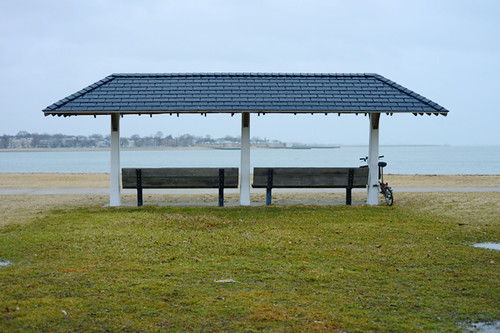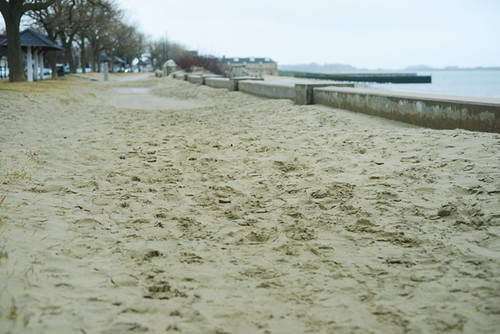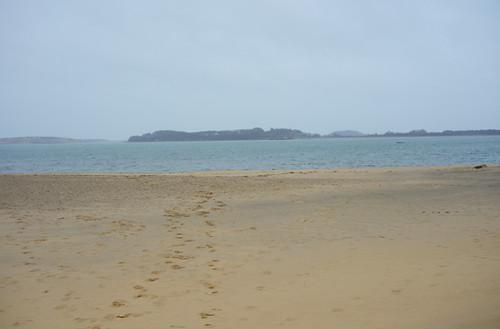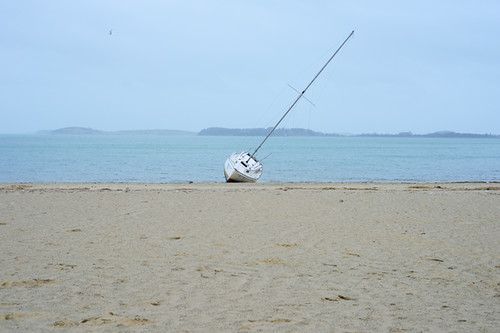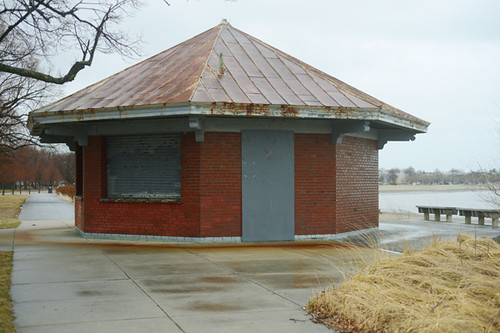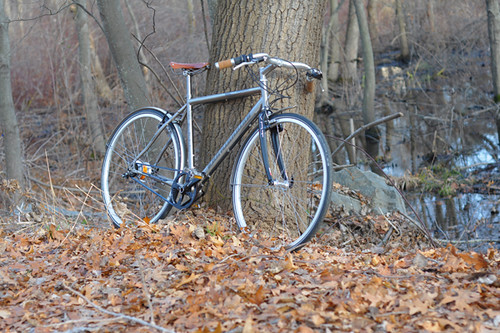
Over the winter holidays I hosted a rather unusual guest from overseas - a titanium Dutch bike. Van Nicholas is a small Netherlands-based manufacturer of titanium road, touring, mountain and cyclocross bicycles. A reader suggested I try a
Van Nicholas after I reported enjoying other Ti bikes, and thanks to him a test ride was soon arranged. What made
Van Nicholas particularly noteworthy, I was told, is that one of their models - the Amazon - made for a uniquely comfortable transportation bicycle, combining aspects of the workhorse utility bikes Holland is known for with the special properties of titanium. Add to that a couple of fancy features afforded by modern technology (a 14-speed
Rohloff hub and a belt drive), and the
Van Nicholas Amazon seemed very interesting indeed.
Based on my understanding of the sizing, I asked for a 54cm bike. The bikes are customizable, and so I also asked for it to be fitted with swept back handlebars, a leather saddle and flat pedals. The American distributor (EU Cycling Imports) sent the demo model to the Ride Studio Cafe in Lexington MA, and they put the bicycle together for me. I took it home to test ride and brought it back two weeks later, after which the bike was returned to the distributor. It should be noted that the
Ride Studio Cafe carries a certain local brand of titanium bicycles, which is technically a competitor of
Van Nicholas. But this did not seem to bother anyone and the
RSC displayed the
Van Nicholas right on the sales floor along with the
Seven bikes for customers to admire. It was a treat to see two different titanium brands side by side.
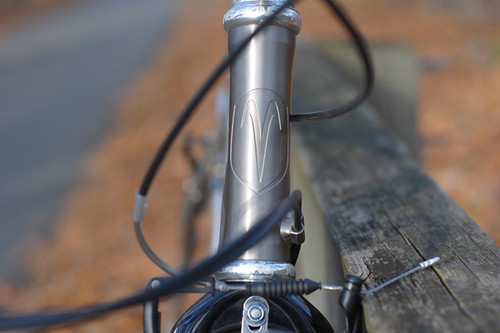 Van Nicholas
Van Nicholascame into existence 12 years ago and was founded as a brand in 2006. The frames are designed in Numansdorp, Netherlands, built in the Far East (I was not told which country), then finished, assembled and tested back in the Netherlands. The titanium tubing differs in thickness and composition based on the frame model and size. The Amazon is made with stout tubing, designed for touring and for supporting heavy loads. The frame is unpainted, with a brushed matte finish. The headbadge is chemically etched into the frame. Components that come standard with the build are high quality. The stem, seatpost and seat collar are also titanium, branded with
Van Nicholas insignia.

The tiny titanium bell is pretty impressive. I forgot to ask whether they sell some of these Ti parts separately, because I certainly would not mind a titanium seatpost and bell.

The manybraze-ons for cable routing keep the cables very neat, which is a good thing because there are lots of them thanks to the
Rohloff hub. There are also braze-ons for racks, water bottle cage bosses, and everything else one would expect from a touring frame.

The fork that comes with the bike is carbon fiber, labeled "VNT Elements" - a house brand I think.There are cantilever/v-brake bosses on it, which sort of horrifies me even though I know this is not uncommon nowadays (but how does the carbon fork withstand the force of the mighty v-brake?..).
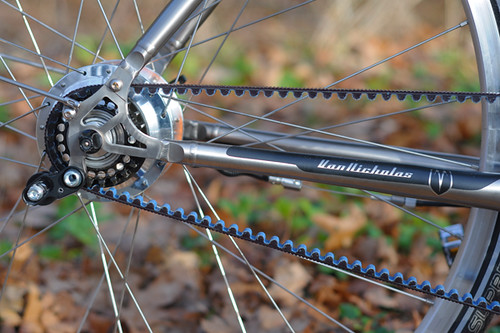
Special dropouts that can be split apart for the belt drive and also accommodate the massive
Rohloff hub, with a built-in mount for the "belt keeper" that prevents the belt from slipping in snowy and muddy conditions.
 Brooks
Brooks Swallow saddle with titanium rails,
FSA Metropolis handlebars,
Rohloff twist shifter and
Brooks leather washer grips. The brown leather accessories warmed up the titanium frame and I found the combination appealing. The handlebars are a modern take on the classic upside down North Roads and this added a touch of an almost vintage look to the whole thing.

When I first saw the bike, more than anything I was overwhelmed by all its bells and whistles. A titanium frame, a carbon fork with canti mounts, a
Rohloff hub and a belt drive all on the same bike? It was a lot to wrap my head around. I am glad that at this point I'd ridden several other titanium bikes, and also another bike with a belt drive - so that at least all of these elements were not simultaneously new to me.
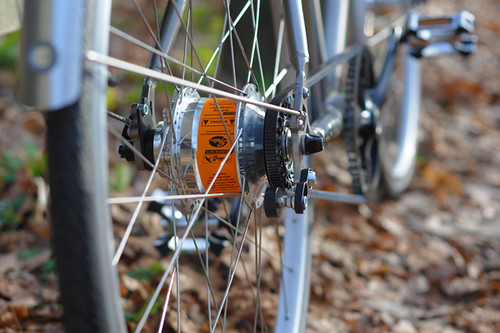
The
Rohloff hub was the one feature I had not tried before. On first impression I immediately disliked it, because it made the bicycle ridiculously rear-heavy. On a lightweight titanium frame this was especially noticeable: I'd pick up the bike by the top tube, and the rear wheel would pull it backward like a ball and chain. I am not a fan of multi-geared hubs, and anything beyond a 3-speed I usually find annoyingly inefficient. I could already anticipate the same happening with the
Rohloff: At such a monstrous weight, surely the 14 speeds with the alleged 526% gear range were a gimmick that in practice would not live up to the numbers' promise.
Taking the bike on its maiden test ride, I headed straight for the hills of Lexington MA to test this hypothesis. And my hypothesis proved to be incorrect. I approached a long, unpleasant hill and was able to climb it at a leisurely pace by utilizing the 3rd and 2nd gears. I did not feel the bike's rear-heaviness whilst in motion and spun without getting out of breath or even especially exerting myself. If I lived in a seriously hilly area, I could travel to work like this in ordinary clothing without getting sweaty. Later I rode the bike to my art studio, which is also on top of a steep hill, and in 4th gear I did not feel this hill at all. The
Rohloff hub is heavy and that has its drawbacks, but I found the range of gearing it provided to be very satisfactory and on par with my derailleur-geared bikes. I am wondering now to what extent the performance of the hub in this case had to do with its interaction with the titanium frame. On a heavier frame, would it still get me up the same hills? This question remains open, so please keep in mind that my experience with the
Rohloff so far is limited to this specific bike.

The
Rohloff shifter took some getting used to, because if you are accustomed to standard twist shifters this one functions in reverse: For a lower gear you twist toward you and for a higher gear you twist away from you. I did not manage to get used to this during my two weeks with the bike and would occasionally shift in the opposite direction than I meant to. I was very glad however that I did not have to constantly switch gears just to ride at the pace I wanted to in the city. The 9th gear was my standard gear, and unless I ventured into hilly terrain I pretty much stayed in it. The bicycle responded very well to my pedaling efforts both uphill and on flats.
It's been explained to me how
Rohloffhubs work, and apparently it is like having an internal derailleur with a double crankset. So if I understand this correctly, there is a gear at which point the mechanism automatically switches not just between the internal rear cogs, but also from one internal chainring to another. A couple of owners of older model
Rohloff hubs tell me that whatever gear this happens on can be problematic - either sticking or misfiring when one attempts to switch in or out of it. I tried to figure out which gear this was, and judging by the extra grunting/clicking I was hearing, it appeared to be the 6th gear - a gear I only used when going uphill. I made a point to switch in and out of it a few times and did not experience any problems in the course of my test rides.In general, neither the
Rohloff hub nor the
Gates belt drive gave me any trouble over the 55 miles I spent riding this bike through the hilly countryside and stop-and-go city traffic. The drivetrain was very quiet and sort of faded into the background.

While the Amazon comes with braze-ons for racks, the demo model was sent to me without any and initially I fitted the bike with a medium sized saddle bag. There were also no provisions for dynamo lighting, and I used my own battery lights.
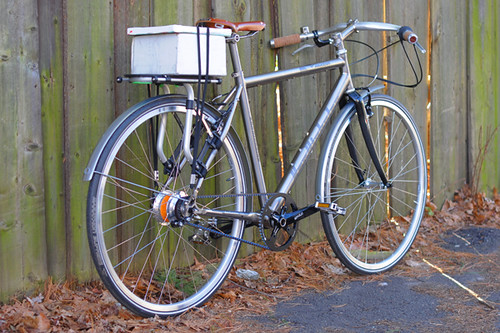
Later we installed a Freeload rack on the bike, so that I could transport packages and my laptop pannier. Aside from one ride done for the sole purpose of testing the bike on hills and over longer distances, I mostly rode the
Van Nicholas for transportation, since that was the context in which I was testing it. Its proportions work well for this purpose. The long (456mm) chainstays allow for optimal pannier clearance; the relaxed head tube angle and long top tube prevent toe overlap with the front wheel. I wore my chunkiest winter boots to test ride the bike and there was not even a chance of toe overlap, which was great.

The handlebars, despite being somewhat swept back, are set very low and you can see that my position on the bike is rather aggressively leaned over. Ideally I would prefer handlebars that are not necessarily higher but more swept back. In other ways the bicycle fit me very well and at 5'7" I was happy with the 54cm frame size. The handling felt familiar and predictable. Not like a classic Dutch bike exactly, but like something I've ridden in the past. Maybe like a Ti version of my
Rivendell, were it set up as an upright bike. For transportation cycling I like this type of handling very much.
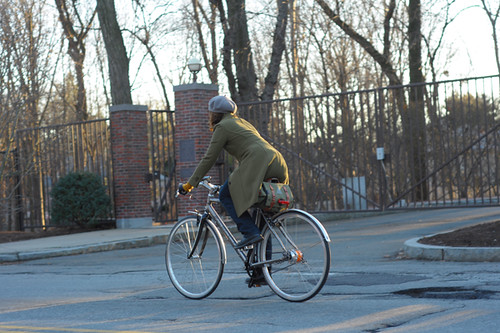
But my favourite part of the
Van Nicholas ride quality was how it felt over rough roads. If you look at the lower righthand corner of the picture above, you will notice there is a ditch in my line of travel. Unfortunately, many roads in the area where we live look like this, and often I end up riding right over those ditches and potholes, because to avoid them would be to zig-zag incessantly. The
Van Nicholas was fine with this type of road surface, despite being fitted with tires only 32mm wide (the frame's maximum tire clearance is 2.35", so it is possible to fit much wider tires). I could ride through a ditch like the one you see here and feel only a distant echo without the bone-shaking feeling. As I've written before, I've noticed this same detached "echo" feeling with several titanium bikes so far, so I don't think it would be out of line to speculate that the titanium plays a role here.
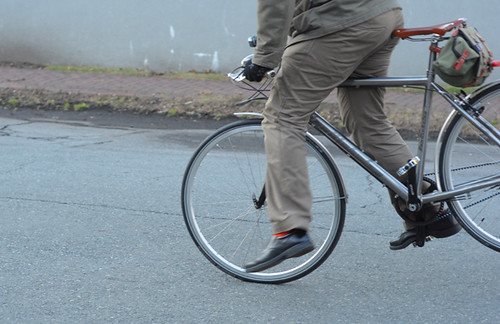
On a critical note, the v-brakes were insanely strong and difficult to modulate. I was not brave enough to demonstrate this, but here the Co-Habitant shows what happens when squeezing the front brake with moderate force. We would have to mess with the brake to adjust it in a way that would prevent this, but decided to leave it alone and instead I simply used the rear brake only.
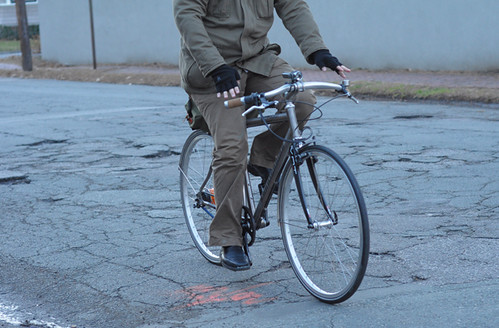
Test riding the bikebriefly, the Co-Habitant also noted that he was unable to comfortably ride it hands-free (I would not know, as I do not normally ride hands-free anyhow). The frame was a couple of sizes too small for him, but I doubt this played a role. It could be that the weight of the
Rohloff hub and the saddlebag made the front end too light for hands-off riding.
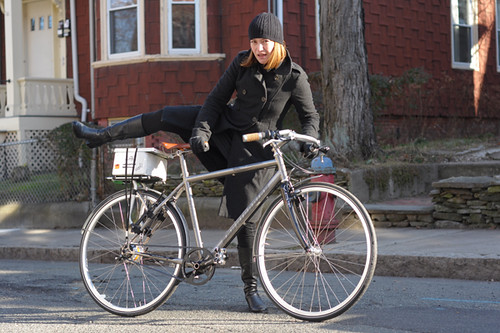
Me, I was very pleased with the handling and the ride quality of the
Van Nicholas Amazon and would have been tempted to covet it for my own if it were not for the diamond frame. Try as I might, I am just not comfortable riding diamond frames for transportation in my everyday clothing. Yes I can do it, but I prefer not to. My long coat or skirt inevitably get caught on something as I swing my leg over to mount or dismount the bike, and I am too clumsy to handle this on a regular basis. So despite the great ride quality, the amazingly versatile
Rohloffhub gearing, and the silent and maintenance-free belt drive, I ultimately feel more comfortable on my own bike. I should note that
Van Nicholas does make a ladies version of the Amazon, but I find the MTB step-through frame design unbearably ugly. Looks are not everything, but the welded titanium and the carbon fork already stretch the limits of my open-mindedness and I am only human. If they managed to make a more attractive step-through or mixte option however (like this please!), I would be in trouble and would desire this bicycle very badly. Offering a dynamo lighting package would also be a huge plus on a bicycle like this - whether it is used for touring or transportation.

The
Van Nicholas Amazon is a unique bicycle in that it is durable enough for year-round, all-weather transportation and comfortable on bad roads, while also being sufficiently light and versatile to handle serious hill grades over long distances. Something like this cannot be achieved without the
Rohloff hub and the lightweight Ti frame, which makes its high cost inevitable. But for those who can afford it and for whom the diamond frame is not an issue, the Amazon is worth looking into.
Van Nicholasbicycles areavailable with both stock and custom options, and the full specs, geometry and other details of the Amazon are available here. More of my pictures can be viewed
here
. Many thanks to
Van Nicholasand
EU Cycling Imports for the opportunity to try this bicycle.










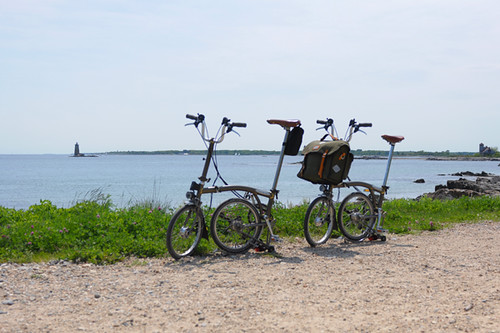
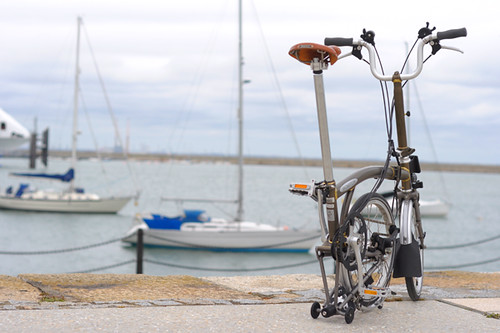
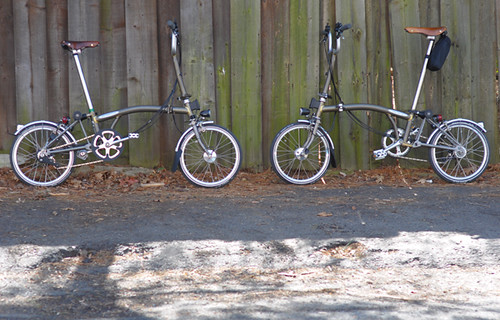
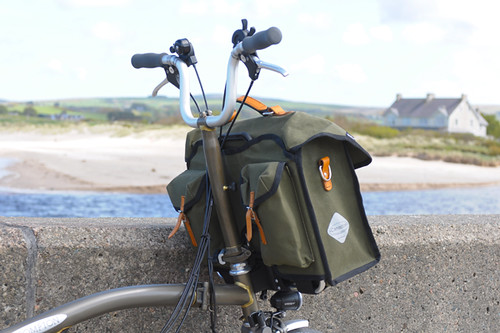
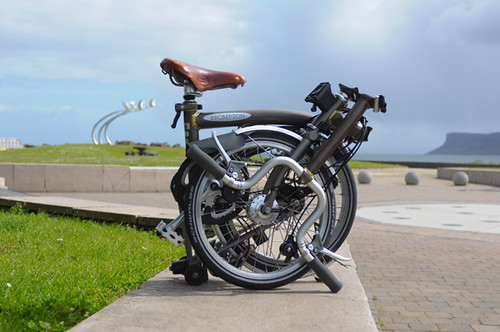
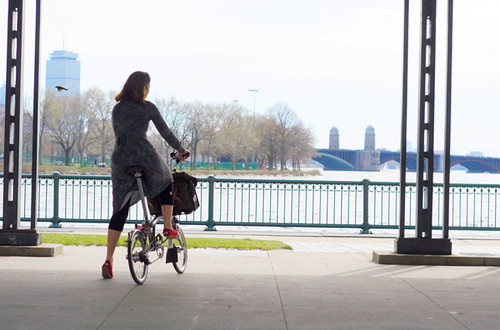
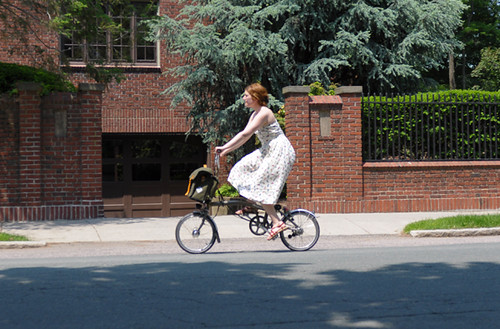
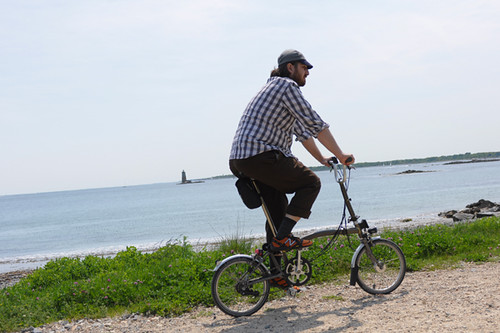
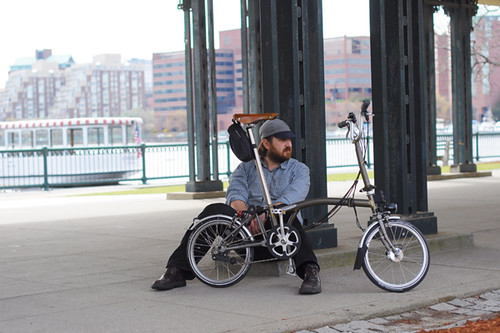
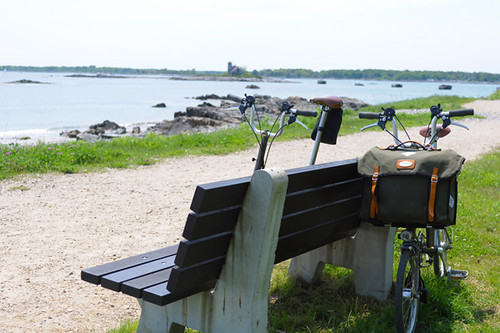
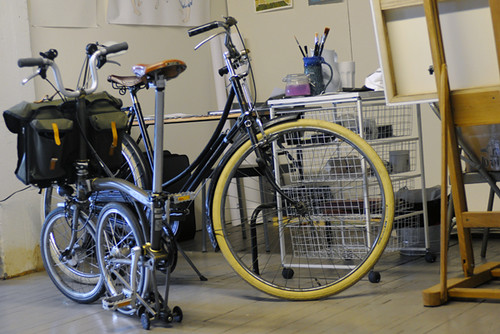

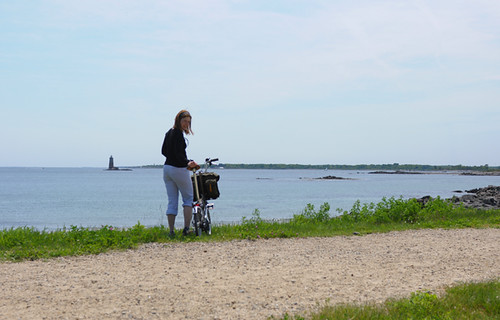



















 A coffee afterstocking up on bird food, thena wander round Fineshade.A muntjac crosses the path, then we spend half an hour in the hide, watching dragonflies, tits, chaffinches, squirrels, a green woodpecker and a jay. The trees are beginning to turn from the top down, the sky's blue, magic.
A coffee afterstocking up on bird food, thena wander round Fineshade.A muntjac crosses the path, then we spend half an hour in the hide, watching dragonflies, tits, chaffinches, squirrels, a green woodpecker and a jay. The trees are beginning to turn from the top down, the sky's blue, magic.


